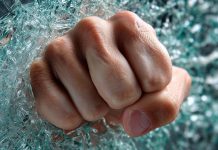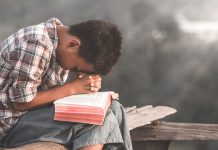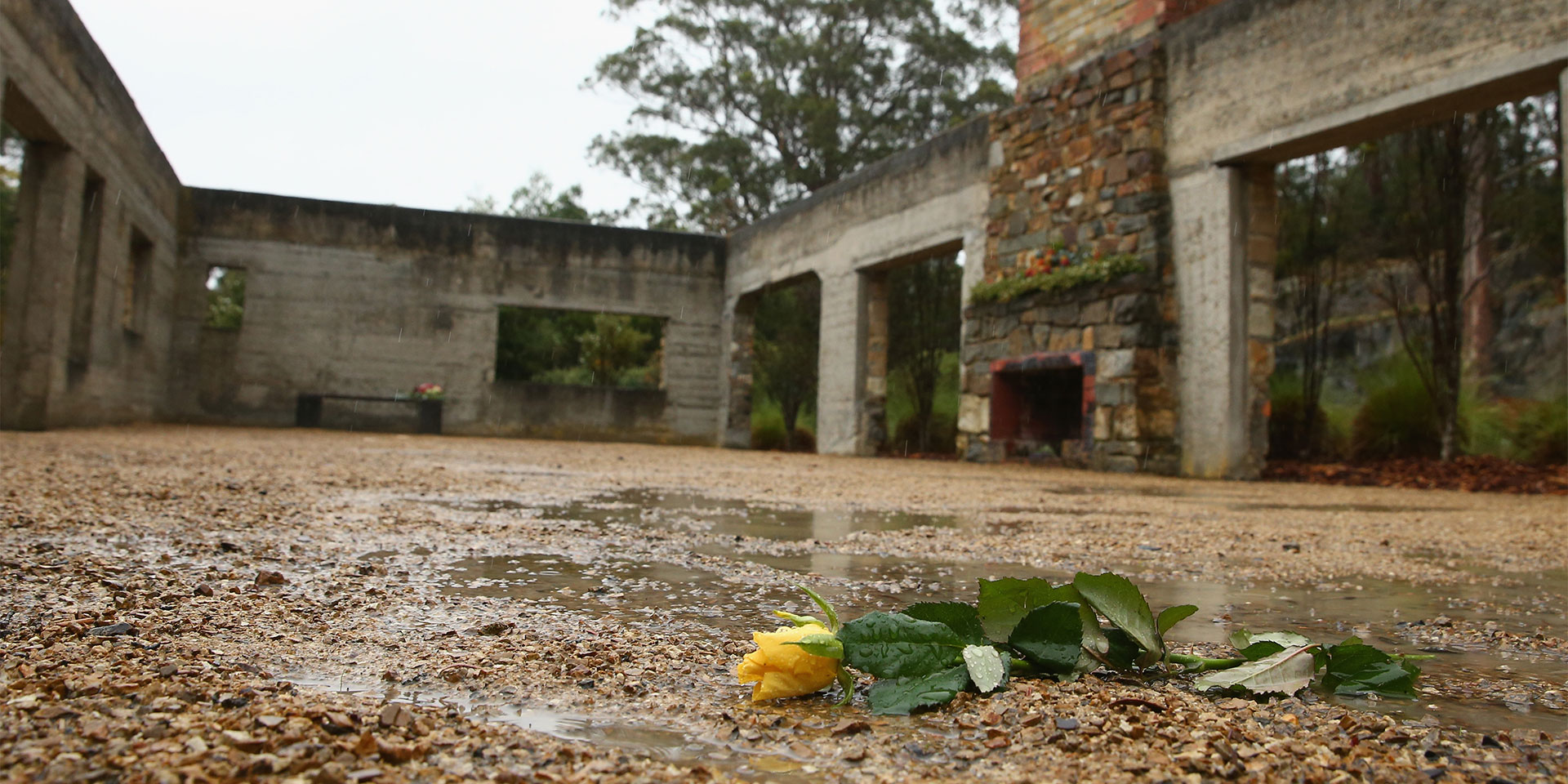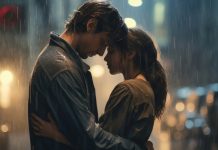I stand in the same spot where it happened 26 years ago. There’s an eerie quietness in the air; even the birds are silent. On the ground lies a small bouquet of withered flowers. The sharp Tasmanian sun pierces through the trees, partially illuminating the grounds of what once was the bustling Broad Arrow café in Port Arthur, south of Hobart.
A stone exterior now occupies the space, while a rectangular water feature and a nearby inscription bear witness to the significance of where I’m standing: Death has taken its toll. Some pain knows no release. But the knowledge of brave compassion shines like a pool of peace.
At the back of the small clearing stands a small, nondescript cross. “In loving memory,” the inscription begins. Thirty-five names are listed, followed by “Sunday 28th April 1996, Port Arthur”.
A small passageway of shrubs guides people to where the café once stood. “What happened here?”— That’s the question asked by the plaque at the entrance. All Australians and many others around the world already know the answer.
Port Arthur Historic Site is a former penal colony. For 20 years, between 1833 and 1853, it housed British convicts—criminals forced to do hard labour. What stands now is a vast property of former buildings and ruins, protected by UNESCO as a World Heritage-listed site. Thousands of tourists flock to the destination to learn about an important part of Australia’s history and to enjoy the idyllic waterfront views.
But that’s not why the name Port Arthur sends a chill down my spine. Twenty-six years ago, those views were the last to be witnessed by a number of unsuspecting visitors to the site. Twenty-eight-year-old Hobart-born Martin Bryant had been eating at the cafe on the site when he pulled out a Colt AR-15 carbine and began shooting at random. Within 60 seconds, 20 people had been killed and another 12 wounded.
He had already murdered two people on his way to the site, and continued his horrific killing spree in the nearby gift shop, car park, toll booth and service station. A tense stand-off with police ensued that night, and he was arrested the following morning, after setting fire to the guest house where he had murdered a hostage.
Thirty-five people died that day and details began emerging of the heinous nature of Bryant’s crimes. Victims as young as three and six years old were slain by Bryant’s monstrous act. Port Arthur was Australia’s worst massacre since World War II and the Federal government was swift in introducing new gun laws—some of the most restrictive in the world. Instances of mass shootings have dramatically decreased since.
These thoughts swelled through my mind as I looked at the names of those on the cross standing in front of me. In that moment, my phone went off and I looked to see a text from my mum. “Did you hear about Christchurch?” she wrote. “No. What happened?” I replied, experiencing a sick premonition that the New Zealand city had just experienced another severe earthquake.
“Siege,” Mum replied.
At the very moment I was standing in the location of one of Australia’s most horrific massacres, New Zealand was experiencing theirs. During my journey back to Hobart, details were emerging of what had happened in Christchurch. A white supremacist had fired at Muslims worshipping in two different mosques, killing 50 and injuring another 50. Adding to the highly disturbing nature of his actions, the attacker had live-streamed the first 17 minutes of his rampage on Facebook for the whole world to see. It was devastating. It was sickening. Words are inadequate to describe these hateful acts.
New Zealand lawmakers, led by Prime Minister Jacinda Arden, were quick to denounce the crime and the role of guns. The attacker had used semi-automatic rifles, shotguns and a lever-action rifle in the attack. New Zealand’s parliament responded with sweeping changes, including banning the sale of military-style semi-automatic weapons and introducing a gun amnesty for the surrender of weapons. The scheme echoes how Australia responded to its own massacre.
These events are just part of a gun-crime epidemic sweeping across the world. The United States, in particular, has the highest rate of mass shootings in the world. Washington Post has kept track of shootings in the US since 1966, and found that 162 mass shootings have been committed, claiming 1153 victims. A total of 309 guns have been used in these acts, 171 of which were obtained legally.
Mass shootings have affected people of different faiths and ethnicities. Muslims were the victims in Christchurch, while on November 5, 2017, 27 Christian worshippers in the First Baptist Church in Sutherland Springs, Texas, were victims of a madman with a gun. Earlier that year, 59 people died when a man in a Las Vegas hotel fired on people at a country music festival below. On June 12, 2016, a gunman entered an Orlando gay nightclub and began shooting, killing 50 and injuring another 53. High school and college shootings have also devastated the United States in recent history.
Too often it’s hate that fuels gun crime. Although stricter gun laws are demonstrably effective, guns don’t kill people by themselves; it’s the person who pulls the trigger. No-one knows this more than Aaron Stark, an ordinary American dad who, in 2018, delivered a TED talk, revealing to the world how close he came to committing a mass shooting in the 1990s. Growing up with physically and mentally abusive, drug-addicted parents, Stark described his thought processes: “I had nothing left to live for, I had literally nothing left to lose. And when you have nothing to lose, you can do anything. And that is a terrifying thought.
“I decided my act of doing something was I was going to express my rage and anger by getting a gun. I was going to attack either my school or a mall food court. It wasn’t about the people, it was about the largest amount of damage in a short amount of time.”
For Stark, the change came when a friend whose trust he had broken on multiple occasions continued to show him kindness. “When someone treats you like a person when you don’t feel like you’re human, it’ll change your entire world. And it did to me. He stopped me with his acts of kindness from committing that atrocity that day.”
What Stark experienced was grace—he didn’t deserve kindness and mercy, but that’s what he received. It’s the same grace that the Bible says we receive from God. Even though we’ve all rejected His guidance and authority and don’t deserve the gift of His love, He gives it anyway. “But God demonstrates his own love for us in this: While we were still sinners, Christ died for us” (Romans 5:8). Grace can change a person’s heart, as Stark found.
“If you see someone that’s in that spot that needs love, give it to them. Love the ones who deserve it the least, because they need it the most…I found my light. I’m a happy family man; I’m a father of four, my wife and my daughter are in the audience today,” Stark said.
As I stand in the spot where the piercing crackle of gunfire drowned out helpless cries, I think about how this worldwide pandemic of gun violence can stop. I never felt unsafe growing up in Australia, because of how my country responded to Port Arthur. But what can I do to prevent tragedies like this from ever happening again?
Jesus’ words come to mind: “Whatever you did for one of the least of these brothers and sisters of mine, you did for me” (Matthew 25:40). All the political and religious motivations behind taking a gun and pulling the trigger are fuelled by hate. Is there a way to stop hate before anyone arms themselves, I wonder?
It’s so close to what Stark said just before walking off the stage to a standing ovation: “We have to give love to those who we think deserve it the least.”
Daniel Kuberek enjoys photography and travel, and is assistant editor of Signs of the Times Australia/New Zealand. He lives in Sydney. A version of this article first appeared on the Signs of the Times Australia/New Zealand website and is republished with permission.



















